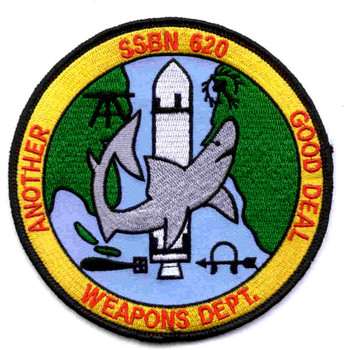Description
US NAVY SSBN-602 USS ABE LINCOLN PATCH "A VERSION" THE SHIP USS ABRAHAM LINCOLN is the fifth Fleet Ballistic Missile submarine in the United States and the first to be built at Portsmouth Naval Shipyard, Portsmouth, New Hampshire. LINCOLN was launched on May 14, 1960 with Miss Mary Mary Lincoln Beckwith Lincoln Beckwith, great grand daughter of Abraham Lincoln, acting as sponsor. On March 11, 1961 ABRAHAM LINCOLN was placed in commission. After her shakedown cruise, LINCOLN will go on station with sixteen Polaris missiles on board. The USS ABRAHAM LINCOLN is 380 feet long with a beam of 33 feet and displacement of 5900 tons. LINCOLN is equipped with an air conditioning system, carbon dioxide scrubbers, carbon monoxide-hydrogen burners, electrostatic precipitator, oxygen storage flasks and an electrolytic oxygen generator to maintain the ship's atmosphere healthful for extended periods of submergence. In addition to the sixteen missile tubes located in the missile compartment aft of the sail, LINCOLN has the firepower of six modern torpedo tubes located in the bow compartment. LINCOLN has six staterooms which accommodate twelve officers. There are 100 bunks for the ship's crew located in the bow compartment and lower level operations compartment. Each bunk has a reading lamp and an adjustable ventilation louver. THE MISSILE SYSTEM First missile launch With almost unlimited cruising range and with endurance limited only by the crew, ABRAHAM LINCOLN is capable of extended submerged operation in the international waters of the world which comprise about 70 percent of the earth's surface. The Polaris missiles will be ready for launch within minutes of receiving the command. Mobile, hidden, ready for instant action (or carefully considered delayed action), the FBM system will provide the United States with a powerful deterrent to those who might start global war. Polaris, named for the North Star, is a two stage, solid fuel, ballistic missile about 28 feet long, four and one-half feet in diameter and weighs 28,000 pounds. Range of the missile is 1200 nautical miles (1380 statute miles). Future development will give the missile a range of 1500 nautical miles. The inertial guidance system used in Polaris is a refinement of earlier inertial systems and is the smallest in use in U.S. ballistic missiles. Two positions must be known for success in missile launching: Target and Launcher. In the FBM system this puts great importance on navigation since the position of the launcher is the position of the ship and is continuously changing. Several methods complement each other on ABRAHAM LINCOLN to provide a very high order of accuracy in determining ship's position. Heart of the system is the ship's inertial navigation system (SINS), a complex system of gyroscopes and accelerometers. LINCOLN has three SINS, each checking the other. A variety of equipment is included in the submarine navigation system to provide an all weather capability of checking on the accuracy of SINS. These include both optical and electronic devices. All are highly automated. THE POWER PLANT ABRAHAM LINCOLN is powered by a nuclear power plant which consists of a nuclear reactor with its associated circulating water and steam cycles and auxiliary machinery. The primary system consists of the reactor, identical port and starboard loops of piping, primary coolant pumps and the tubes of the steam generators. Heat is produced in the reactor by nuclear fission and transferred to the circulating primary coolant water which is pressurized to prevent boiling. This water then passes through the steam generator tubes where it transfers its heat to the shell or secondary side of the steam generator where it boils water to form steam. It is then pumped back to the reactor by the primary coolant pumps where it is heated for the next cycle. The secondary system is the steam producing cycle and is made up of the shell side of the steam generators, turbines, condensers and steam generator feed pumps. It is completely isolated from the primary system. Steam rises from the steam generators, then flows back to the engine room where it drives the ship's service turbo generators supplying the ship with electricity, and the main propulsion turbines which drive the propeller. After passing through the turbines the steam is condensed and the water is fed back to the steam generators by the feed pumps. There is no step in the generation of this power which requires the presence of air or oxygen. This allows the ship to operate completely isolated from the atmosphere for extended periods of time. During operation of the nuclear power plant high levels of radiation exist around the reactor. Large quantities of shielding are used so that the average crew member receives less radiation than that which he would receive from natural sources ashore. - FULLY EMBROIDERED FLAT EDGE WITH CLOTH BACKING
View AllClose






